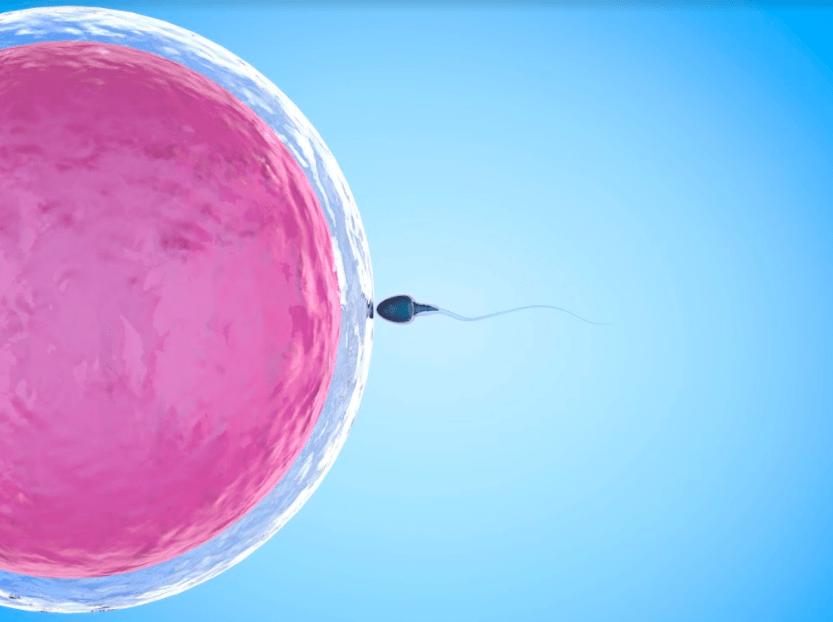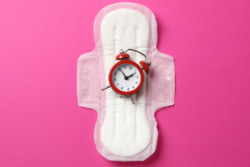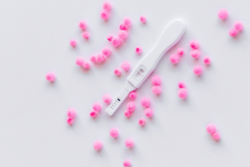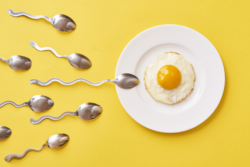Many women understand that feeling of something being off. Some of us may ignore the signs, thinking that our painful periods are normal, or there’s nothing to be done about cyclical acne. But both of these and more are signs and symptoms of hormonal imbalance. Although they might seem benign, for someone who is trying to conceive, they could indicate a larger issue. Major deviations in the normal fluctuations of estrogen, progesterone, and testosterone affect our body on a deeper level. These hormones influence ovulation and indicate the quality of that egg; When we see abnormal levels on blood work, it could indicate that we’re either not ovulating or we’re releasing an ineffective egg.
Here is an overview of some of the most common hormonal imbalances and how they can affect your fertility – and your cycles in general.
Hormonal Imbalance in Women: Estrogen
In a normal menstrual cycle, estrogen first peaks in the follicular phase which leads to the rise in luteinizing hormone (LH) and ovulation. Estrogen sometimes gets a bad reputation, but it’s a necessary hormone and one that influences the ability to release an egg each cycle.
A state of excess estrogen however can be detrimental to fertility. Environmentally we’re exposed to many xenoestrogens: chemical compounds that look and act like estrogen. They’re often found in household cleaning products, plastics, cosmetics, fragrances and/or parfums, and pesticides. But we’re also exposed to ethinyl estradiol, the synthetic estrogen in hormonal contraceptives. Some women take the pill for a decade or longer, ingesting synthetic estrogen daily.
Symptoms of High Estrogen
Here are some common signs and symptoms of excess estrogen. These also tend to be the same side effects that can occur when taking estrogen therapy such as Estrace:
- Long and/or heavy flow periods
- Painful periods
- Fibroids
- Migraines or cyclical headaches
- Anxiety or irritability or rage
There are several problems with excess estrogen. The presence of fibroids or endometrial lesions, both of which are associated with estrogen dominance, can negatively affect implantation. Endometriosis lesions in particular can be located in areas other than the uterus, and can interfere in the function of the ovaries, fallopian tubes and lead to greater pelvic inflammation.
This picture could also look like a relative estrogen dominance if all other hormones, especially progesterone, are low. This highlights the importance of all hormones needing to be in their own physiological normal range, but also in the right concentrations relative to each other. To your body, having low progesterone levels will not only give you symptoms of that low progesterone, but your body will think that estrogen is out of control because of the greater difference in the estrogen to progesterone ratio. This kind of imbalance is common in polycystic ovarian syndrome (PCOS).
Other than symptoms of excess estrogen we also run the risk of increased harmful estrogen metabolites being in our system. When estrogen is metabolized it can be broken down into different types of metabolites. Some of these can cause increased oxidative damage that will affect egg quality, by damaging the DNA within the egg. Others can be considered endocrine disruptors that can turn on other genes and affect hormone balance.
Although less common, low estrogen can also be a problem in fertility. By cycle day 7 or 8, your body has selected one of the follicles in the ovaries to be the dominant follicle and that follicle produces estrogen as it grows. If estrogen levels are low in the follicular phase, it could indicate that the follicle isn’t growing properly. This low estrogen also will prevent the rise in LH levels that cause ovulation.
Symptoms of Low Estrogen
- Hot flashes
- Low mood or depression
- Sleep disturbances
- Vaginal dryness
Hormonal Imbalance in Women: Progesterone
For fertility purposes, progesterone is tested on day 21 (or 7 days post-ovulation). This is different than almost every other hormone test which are typically run on cycle day 3. The reason we test progesterone in the luteal phase is that by this point, the egg that has been released with ovulation should be producing and releasing progesterone. Approximately 7 days post ovulation is when progesterone levels should be at their highest. By measuring progesterone here, we can find out if ovulation likely took place and if the egg was healthy enough to produce an adequate amount of progesterone to facilitate implantation. Low luteal progesterone decreases the ability for the uterine lining to thicken enough for implantation. It can also be associated with shorter cycles.
Symptoms of Low Progesterone
Many symptoms associated with low progesterone are the same or similar to excess estrogen. Additional symptoms may include:
- Mid-cycle spotting
- Irregular cycles
Symptoms of High Progesterone
High progesterone on the other hand — or for those taking progesterone therapy — will notice a very different set of symptoms including:
- Bloating
- Brain fog
- Breast swelling and tenderness
- Constipation
- Fatigue
- Low mood or depression
- Sleep disturbances
- Weeping or easy to cry
Hormonal Imbalance in Women: Testosterone
Although testosterone levels are significantly higher in men than women, testosterone plays an important role in hormone regulation in women. In fact, the relationship between estrogen and testosterone is closer than you think. Testosterone is easily converted into estrogen by an enzyme called aromatase and there are many factors that activate this pathway including stress, inflammation, excess body adipose tissue, and alcohol consumption. Genetics also plays into this: if you have a gene that causes high activity of aromatase, you could be over converting, leading to high levels of estrogen.
High levels of androgens and testosterone are common in cases of PCOS. Other causes include chronic stress and low-grade inflammation.
Symptoms of High Testosterone
Symptoms associated with high androgens include:
- Facial hair growth
- Acne
But wait, doesn’t testosterone support libido? Why would it be bad to have more of this? Testosterone actually plays a very key role at the beginning of the follicular phase in our cycles. Testosterone is produced by the preantral follicles in our ovaries and supports the eventual increase in estrogen (as testosterone is converted into estrogen) during the follicular phase. Too much testosterone promotes the abnormal growth of these early follicles (which can lead to the polycystic ovaries of PCOS). Meanwhile, too little testosterone means that the follicles might not be growing at all, or it could be a case of primary ovarian insufficiency or low ovarian reserve.
The other problem is that abnormally high levels of testosterone will do one of two things: It can convert into DHT (which will happen especially if progesterone is low) which gives you those symptoms of unwanted facial hair growth and acne, or it converts into estrogen leading to an estrogen excess. Either way, the balance is off and this will affect fertility.
Hormonal Imbalance in Men: Testosterone
Hormonal imbalances can occur in men and can lead to changes in fertility status. Specifically, decreased levels of testosterone can affect sperm, which occurs more commonly as men age. In the United States, low testosterone has been reported in about 39% of men over the age of 45, but it’s also common in men who are being treated for infertility (about 15-30% of patients). Clinical guidelines suggest that when sperm concentrations are less than 10 million per mL, a hormonal panel, including androgens and luteinizing hormone (LH) should be evaluated.
Having low testosterone can impair the production of sperm. Additionally, one study observed that men with testosterone levels less than 264ng/dL were more likely to have abnormal sperm morphology.
Symptoms of Low Testosterone
Other symptoms of low testosterone in men include: decreased libido, sexual dysfunction, fatigue, and an increase in fat mass.
One major association with low testosterone is the presence of varicoceles and surgical repair of the varicocele may help to restore levels. Low testosterone can also be a result of testicular trauma, infection, and surgery.
In a study by Trussell et al (2019), men with low testosterone levels (<264ng/dL) were more likely to have a higher body mass index (BMI), and this finding was statistically significant (p <0.001).
So how does this translate to fertility outcomes? In the above study, couples with a male partner with low testosterone had a lower rate of live birth (18.8% vs 27.5% in couples with a male partner with testosterone levels >264ng/dL).
In any male partner with poor sperm parameters, a hormone panel should be conducted. As BMI is so closely linked to low testosterone, treatment for low serum levels should include a diet and lifestyle review to maintain a healthy BMI and body composition.
Treating Hormonal Imbalances Naturally …
As you can tell, all of these hormones are in a constant cycle, but also in balance. Each one has a specific role to play at a very specific time, and although there are negative aspects to having too much or too little of any given hormone, that difference alone will impact the function of all other sex hormones.
These changes might present to us as just “bad PMS” but they can indicate a major upset in our fertility status. Anyone who has been under an incredible amount of stress and experienced a missed period or abnormal period can understand this. Unfortunately, it’s not just our periods that are affected – this can be a symptom of something being very wrong with the egg we are supposed to have ovulated.
The encouraging news is that there are so many treatment options to correct these balances! One of the best ways to get started is to focus on diet and lifestyle.
- Get stress under control or work on stress management
- Get an adequate amount of good sleep
- Eat a supportive diet full of fresh vegetables, proteins and healthy fats, and cut out the sugar and alcohol
- Enjoy moderate exercise
- Take care of your mental health
Once the foundation is built, your team of experts, including your fertility naturopath and reproductive endocrinologist or gynecologist can further provide a treatment plan to support your fertility.
To learn more about how you can support your fertility, or to book a virtual appointment with a Conceive Health ND, contact us today.
References:
Majzoub A and Sabanegh Jr E. (2016). Testosterone replacement in the infertile man. Transl Androl Urol. 5(6): 859-65
Trussell JC, Coward RM, Santoro N, et al. (2019). Associations between testosterone, semen parameters, and live birth in men with unexplained infertility in an intrauterine insemination population. Fertil Steril. 111(6): 1129-34









